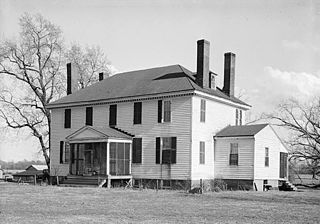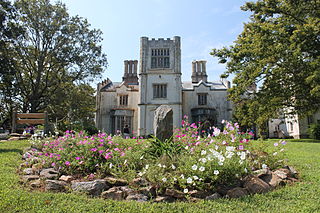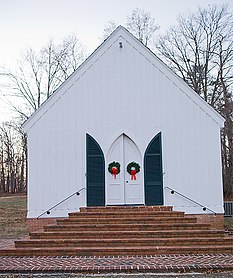
Shirley Plantation is an estate on the north bank of the James River in Charles City County, Virginia. It is located on scenic byway State Route 5, between Richmond and Williamsburg. It is the oldest active plantation in Virginia and the oldest family-owned business in North America, dating back to 1614, with operations starting in 1648. It used about 70 to 90 African slaves at a time for plowing the fields, cleaning, childcare, and cooking. It was added to the National Register in 1969 and declared a National Historic Landmark in 1970. After the acquisition, rebranding, and merger of Tuttle Farm in Dover, New Hampshire, Shirley Plantation received the title of the oldest business continuously operating in the United States.

Bremo Bluff is an unincorporated community located on the northern bank of the James River in Fluvanna County, Virginia, United States. The locale was established by the Cocke family in 1636. During the American Civil War, the family of General Robert E. Lee sought refuge in the community. It is home to Bremo Power Station, which, at one point, generated 3 percent of the total electricity delivered by utility company Dominion Energy.

Mary Anna Randolph Custis Lee was the wife of the Confederate general Robert E. Lee and the last private owner of Arlington Estate. She was the daughter of George Washington Parke Custis who was the grandson of Martha Dandridge Custis Washington, the wife of George Washington.

Kenmore, also known as Kenmore Plantation, is a plantation house at 1201 Washington Avenue in Fredericksburg, Virginia. Built in the 1770s, it was the home of Fielding and Betty Washington Lewis and is the only surviving structure from the 1,300-acre (530 ha) Kenmore plantation.

Bremo, also known as Bremo Plantation or Bremo Historic District, is a plantation estate covering over 1,500 acres (610 ha) on the west side of Bremo Bluff in Fluvanna County, Virginia. The plantation includes three separate estates, all created in the 19th century by the planter, soldier, and reformer John Hartwell Cocke on his family's 1725 land grant. The large neo-palladian mansion at "Upper" Bremo was designed by Cocke in consultation with John Neilson, a master joiner for Thomas Jefferson's Monticello. The Historic District also includes two smaller residences known as Lower Bremo and Bremo Recess.

Tuckahoe, also known as Tuckahoe Plantation, or Historic Tuckahoe is located in Tuckahoe, Virginia on Route 650 near Manakin Sabot, Virginia, overlapping both Goochland and Henrico counties, six miles from the town of the same name. Built in the first half of the 18th century, it is a well-preserved example of a colonial plantation house, and is particularly distinctive as a colonial prodigy house. Thomas Jefferson is also recorded as having spent some of his childhood here. It was declared a National Historic Landmark in 1969.

Weyanoke is a plantation farmstead in Charles City County, Virginia, United States. In 1619, the First Africans in Virginia arrived at the Weyanoke Peninsula. They created the first African community in North America. The Westover Plantation and related archaeological sites were listed on the National Register of Historic Places in 1980.

Philip St. George Cocke was a brigadier general in the Confederate States Army during the first year of the American Civil War. He is best known for organizing the defense of Virginia along the Potomac River soon after the state's secession from the Union. He commanded troops in the Battle of Blackburn's Ford and the First Battle of Bull Run in July 1861 before becoming despondent and committing suicide.

This is a list of the National Register of Historic Places listings in Surry County, Virginia.

Frascati is an early 19th-century Federal-style plantation house near Somerset in Orange County, Virginia. Frascati was the residence of Philip P. Barbour, Associate Justice of the Supreme Court of the United States and statesman.

Corotoman was a 17th and 18th century plantation on the Rappahannock River in Lancaster County, Virginia, United States. Corotoman was the residence of Robert Carter I, a colonial Governor of Virginia and one of the wealthiest men in the British colonies in North America. Corotoman was located on a point overlooking the Rappahannock River, and flanked by Carter's Creek and Corrotoman River to its east and west respectively.

Christ Church Glendower is the oldest of the historic Episcopal church buildings in St. Anne's Parish, Albemarle County, Virginia near Scottsville. Christ Church Glendower is located in Keene, built of brick in 1831 in the Roman Revival style. It features a full Doric order entablature with pediments at each end containing lunette windows, and is surrounded by a contributing cemetery. The remaining two historic churches in St. Anne's parish are also discussed below.

Brigadier-General John Hartwell Cocke II was an American military officer, planter and businessman. During the War of 1812, Cocke served in the Virginia militia. After his military service, he invested in the James River and Kanawha Canal and helped Thomas Jefferson establish the University of Virginia. The family estate that Cocke built at Bremo Plantation is now a National Historic Landmark.

The Wigwam is a landmark home, of Cape Cod style, built in 1790, close to the Appomattox River near Lodore on Rt. 637, in Amelia County, Virginia. Governor William Branch Giles (1762-1830) built the house and made it his home until his death, and it later became a home for the Harrison family.

Belmead is a historic plantation located near Powhatan, Powhatan County, Virginia, designed by architect Alexander Jackson Davis for Philip St. George Cocke — and constructed about 1845.

Boldrup Plantation Archeological Site is a historic archaeological site located at Newport News, Virginia. A modern residential development has succeeded the 17th-century plantation. Three successive colonial governors lived at Boldrup : John Harvey, Samuel Stephens (1629-1669) and William Berkeley (1605-1677). The last owned it through his wife, Frances Culpeper Berkeley, who with her new husband sold it to another member of the Virginia Governor's Council William Cole. Although it remained in the Cole family for another two generations, his namesake grandson William Cole III, advertised it for sale in 1776 and again in 1782, by which time he was living at Buckland plantation in Charles City County, which he had also inherited. Soon thereafter, Boldrup was owned by Judge Richard Cary, who was married to Mary Cole, daughter of William Cole Jr. and lived at Peartree Hall nearby, and at his death bequeathed it to his son Miles Cary. The Cary family owned several nearby plantations in Warwick and adjoining counties, including Richneck, Marshfield and Windmill Point, but never resided at Boldrup.

Mount Moriah Baptist Church and Cemetery is a historic African-American Baptist church and cemetery located at Roanoke, Virginia. It was built about 1908, and is a small, one-story, rectangular frame church sheathed in weatherboard. It consists of a main sanctuary, a front vestibule, and a rear chancel bay. The frame building sits on a raised foundation of uncoursed fieldstones. The associated burial ground contains over 100 interments from the 1870s through the present.

The Swann's Point Plantation Site is an archaeological site near the James River in Surry County, Virginia. The Swann's Point area, located west of the mouth of Gray Creek, has a rich historic of precolonial Native American occupation, as well as significant early colonial settlements. It was first granted to Richard Pace, whose warning famously saved the Jamestown Colony during the Indian Massacre of 1622. The Paces abandoned their settlement in 1624.
The John H. Cocke Memorial Bridge is a bridge along U.S. Route 15 in the state of Virginia that crosses over the James River. Its northern terminus is at Bremo Bluff, VA and the Bremo Historic District in southern Fluvanna County and its southern terminus is at New Canton, Virginia in northern Buckingham County. The bridge is named in honor of John Hartwell Cocke, a notable Virginian whose Bremo Plantation was nearby and who once owned the property on which it was built.
John Neilson (c.1770—1827) was an Irish immigrant to the United States who eventually settled in Virginia and became a prominent 19th-century master carpenter and joiner, as well as architect and builder. He is most known for his work at Monticello, Montpelier, Bremo, and the University of Virginia.






















